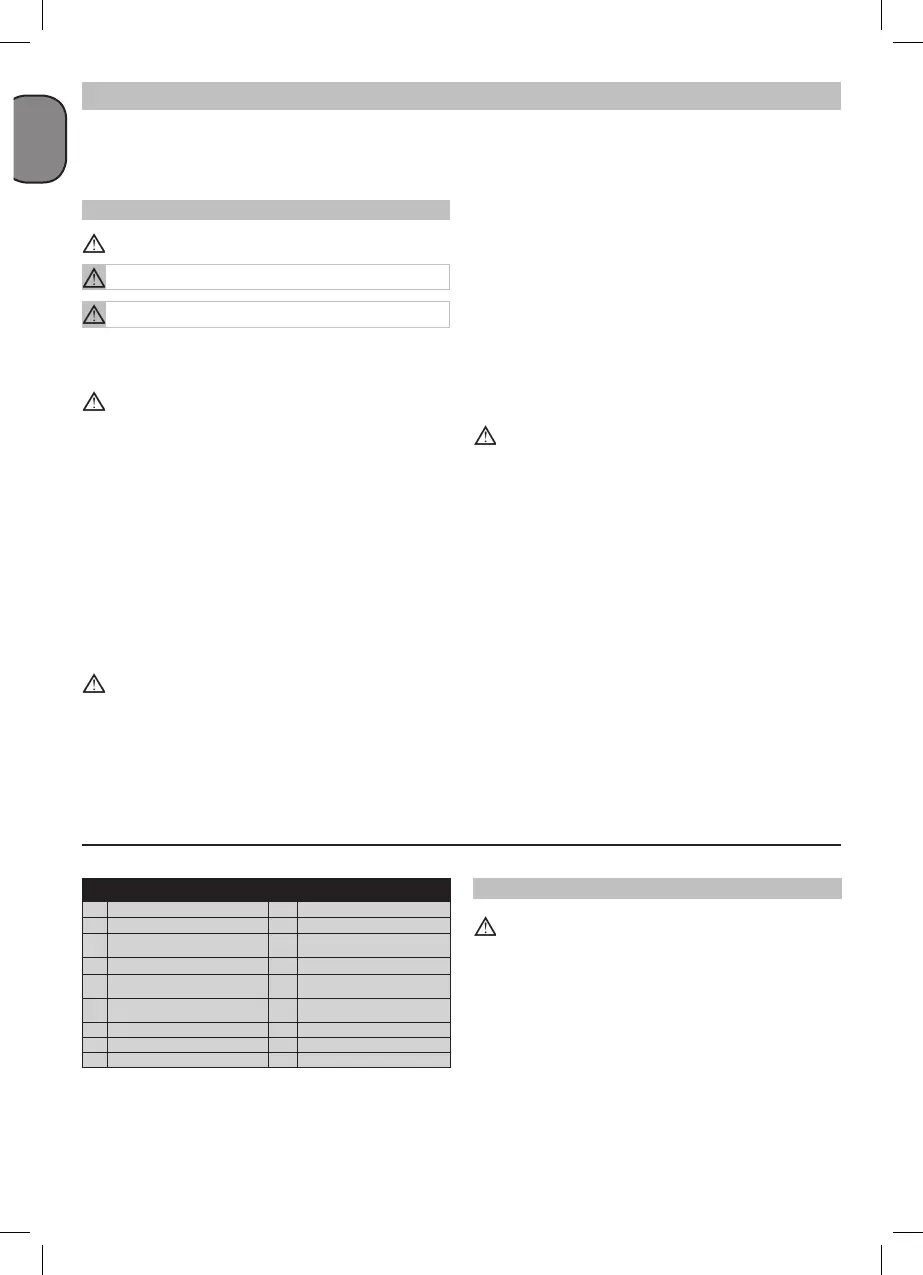G
B
Before using the compressor, read the instructions for use carefully and
comply with the following safety precautions. Consult this handbook if
you have any doubts regarding functioning.
Preserve all the documentation so that anyone who uses the
compressor can consult this beforehand.
SAFETY RULES
1
This symbol indicates warnings to be read before using the product so as
to prevent injury to the user.
Compressed air is a potentially dangerous form of energy; always take
great care when using the compressor and its accessories.
Warning: the compressor may restart when power is restored following
a blackout.
An ACOUSTIC PRESSURE value of 4 m. corresponds to the ACOUSTIC
POWER value stated on the yellow label located on the compressor,
minus 20 dB.
THINGS TO DO
● The compressor must be used in a suitable environment (well
ventilated with an ambient temperature of between +5°C and +40°C)
and never in places affected by dust, acids, vapors, explosive or
flammable gases.
● Always maintain a safety distance of at least 4 meters between the
compressor and the work area.
● Any coloring of the belt guards of the compressor during painting operations
indicates that the distance is too short.
● Inserttheplugoftheelectriccableinasocketofsuitableshape,voltage
andfrequencycomplyingwithcurrentregulations.
● Use extension cables with a maximum length of 5 meters and of suitable
cross-section.
● The use of extension cables of different length and also of adapters and
multiple sockets should be avoided.
● Always use the switch I/O to switch off the compressor.
● Always use the handle to move the compressor.
● Whenoperating,thecompressormustbeplacedon astable,horizontal
surface.
THINGS NOT TO DO
● Neverdirectthejetofairtowardspersons,animalsoryourbody.(Always
wear safety goggles to protect your eyes against flying objects that may be
liftedbythejetofair).
● Neverdirectthejetofliquidssprayedbytoolsconnectedtothecompressor
towards the compressor.
● Never use the appliance with bare feet or wet hands or feet.
● Never pull the power cable to disconnect the plug from the socket or to
move the compressor.
● Never leave the appliance exposed to adverse weather conditions.
● Never transport the compressor with the receiver under pressure.
● Donotweldormachinethereceiver.Inthecaseoffaultsorrusting,replace
the entire receiver.
● Never allow inexpert persons to use the compressor. Keep children and
animals at a distance from the work area.
●Thisapplianceisnotintendedforusebypersons(includingchildren)with
reduced physical, sensory or mental capabilities, or lack of experience
and knowledge, unless they have been givensupervisionorinstruction
concerning the use of the appliance by a person responsible for their
safety.
● Children should be supervised to ensure that they do not play with the
appliance.
● Donotpositionflammableornylon/fabricobjectsclosedtoand/oronthe
compressor.
● Nevercleanthecompressorwithflammableliquidsorsolvents.Checkthat
you have unplugged the compressor and clean with a damp cloth only.
● The compressor must be used only for air compression. Do not use the
compressor for any other type of gas.
● The compressed air produced by the compressor cannot not be used
for pharmaceutical, food or medical purposes except after particular
treatments and cannot be used to fill the air bottles of scuba divers.
THINGS YOU SHOULD KNOW
●
To avoid overheating of the electric motor, this compressor is
designed for intermittent operation as indicated on the technical
dataplate(forexample,S3-25means2.5minutesON,7.5minutesOFF).In
thecaseofoverheating,thethermalcutoutofthemotortrips,automatically
cutting off the power when the temperature is too high. The motor restarts
automatically when normal temperature conditions are restored.
● All the compressors are fitted with a safety valve that is tripped in the case
of malfunctioning of the pressure switch in order to assure machine safety.
Thesafetyvalveissettoavoidover-pressurizationoftheairtanks.This
valveisfactorypre-setandwillnotfunctionunlesstankpressurereaches
this pressure. Do not attempt to adjust or eliminate this safety device.
Any adjustments to this valve could cause serious injury. If this device
requiresserviceormaintenance,seeanAuthorizedServiceCenter.
● Whenfittingatool,theflowofairinoutputmustbeswitchedoff.
● The red notch on the pressure gauge refers to the maximum operating
pressure of the tank. It does not refer to the adjusted pressure.
● Whenusingcompressedair,youmustknowandcomplywiththesafety
precautionstobeadoptedforeachtypeofapplication(inflation,pneumatic
tools,painting,washingwithwater-baseddetergentsonly,etc.).
● Please check that the air consumption and the maximum working pressure
ofthepneumatictoolandconnectionpipes (withthe compressor)to be
used,arecompatiblewiththepressuresetonthepressureregulatorand
with the amount of air supplied by the compressor.
● Do not cover the air inlets on the compressor.
● Do not open or tamper with any part of the compressor. Contact an
authorized Service Center.
COMPONENTS (fig. 1 - 2 - 3 - 4 - 5 - 6 - 7 - 8 - 9)
1. Shroud 10. Safety valve
2. Pressurevessel(tank) 11. Receiver condensation drainage tap
3. Wheel 12.
Pressuregauge(forreadingthetank
pressure)
4. Rubber foot 13. Axle
5.
Quick-lockcoupling(regulated
compressedair)
14. Clip
6.
Pressuregauge(forreadingthepreset
pressurebymeansofregulator)
15. Screw
7. Pressure regulator 16. Nut
8. I/O switch 17. Washer
9. Transportation handle
ASSEMBLY
2
You must fully assemble the appliance before using it for the first time.
Fitting the wheels
FitthesuppliedwheelsasshowninFig.2,3,4,5&6:
● Fig.2a&2b:Assemblyofwheelkit-versionA
Assemblybysequence:a,b,c,d,e
● Fig.3a&3b:Assemblyofwheelkit-versionB
● Fig.4:Assemblyofwheelkit-versionC
● Fig.5:Assemblyofwheelkit-versionD
● Fig.6:Assemblyofwheelkit-versionE
Fitting the rubber foot (ref. 4)
Fit the supplied rubber stopper as shown in Fig. 7.
Fitting the transport handle (for models envisaging this)
Screwthetransporthandletothecompressorasshowningure8.
Preserve this handbook for future reference
